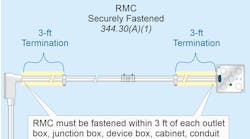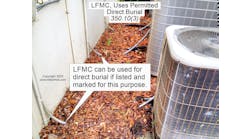Q. When installing an outdoor antenna, can I ground the antenna and lead-in cable to a new 8-ft grounding rod?
A. No. You must bond telecommunications systems [Sec. 800-40(b)], antennas and lead-in cables [Sec. 810-21(f)], CATV [Sec. 820-40(b)], and network-powered broadband communications systems [Sec. 830-40(b)] to one of the following locations:
-
Building or structure grounding electrode system, as described in Sec. 250-50.
-
Interior metal water pipe meeting the requirements of Sec. 250-104(a). The limitation of 5 ft in Sec. 250-50 does not apply.
-
Metal service raceway.
-
Service equipment enclosure.
-
Building or structure grounding electrode conductor.
-
Metal enclosure housing the building or structure grounding electrode conductor.
-
Accessible bonding means, such as 6 in. of No. 6 copper conductor, connected to the service equipment or raceway [Sec. 250-92(b)].
Q. A 230V central air-conditioning unit specifies a maximum 45A fuse or HACR breaker, with a minimum circuit ampacity of 27.8A. Can I use No. 10 THHN with a 40A HACR breaker?
A. Yes. Conductors supplying a motor compressor with additional load(s) shall have an ampacity not less than 125% of the highest motor or motor-compressor rating in the group, plus the other loads (Sec. 440-33).
Example: A/C with the following loads: compressor 18.7A, OD motor 1.8A, ID motor 2.6A.
Conductor nameplate size = 18.7A x 1.25 + 1.8A + 2.6A = 27.8A.
The NEC permits the protective device to have a rating or setting not exceeding 175% of the largest motor compressor-rated load current, plus the other loads. Where the protection at 175% is not sufficient for the starting current of the motor, you can increase the protection rating to 225% of the largest motor compressor-rated load current, plus the other loads [Sec. 440-22(b)].
Example: A/C with the following loads: compressor 18.7A, OD motor 1.8A, ID motor 2.6A.
Protection nameplate size = 18.7A x 2.25 + 1.8A + 2.6A = 46.48A (next size down =45A).
Q. I'm installing a 1200A service (three sets of 600kcmil per phase). What is the largest grounding electrode conductor the NEC requires for this service?
A. Sec. 250-66 says the sizing of the grounding electrode conductor is based on the type of electrode used:
Ground rod/plate electrode [Sec. 250-66(a) ]. Where the grounding electrode conductor connects to a ground rod or plate electrode [Sec. 250-52(c)(d)], the Code does not require that portion of the conductor that is the sole connection to the grounding electrode to be larger than No. 6 copper wire.
Concrete-encased electrodes [Sec. 250-66(b) ]. Where the grounding electrode conductor connects to a concrete-encased electrode [Sec. 250-50(c)], the Code does not require that portion of the conductor that is the sole connection to the grounding electrode to be larger than No. 4 copper wire.
Ground rings [Sec. 250-66(c) ]. Where the grounding electrode conductor connects to a ground ring [Sec. 250-50(d)], the Code does not require that portion of the conductor that is the sole connection to the grounding electrode to be larger than the conductor used for the ground ring. Note: A ground ring must be bare copper not smaller than No. 2, but it's often sized much larger.
Other electrodes. Where the grounding electrode conductor connects to any other electrode [Sec. 250-50], the conductor shall not be less than given in Table 250-66.
Q. I'm terminating No. 14 THHN stranded wire to a circuit breaker. One of the electricians on the job said terminating stranded wire to a breaker was a Code violation and that the NEC requires a fork connector whenever we terminate stranded No. 14 or No. 12 wire. Is this true?
A. No. The Code lists circuit breakers, receptacles, switches, and other devices for the termination of stranded wire on terminal screws.



